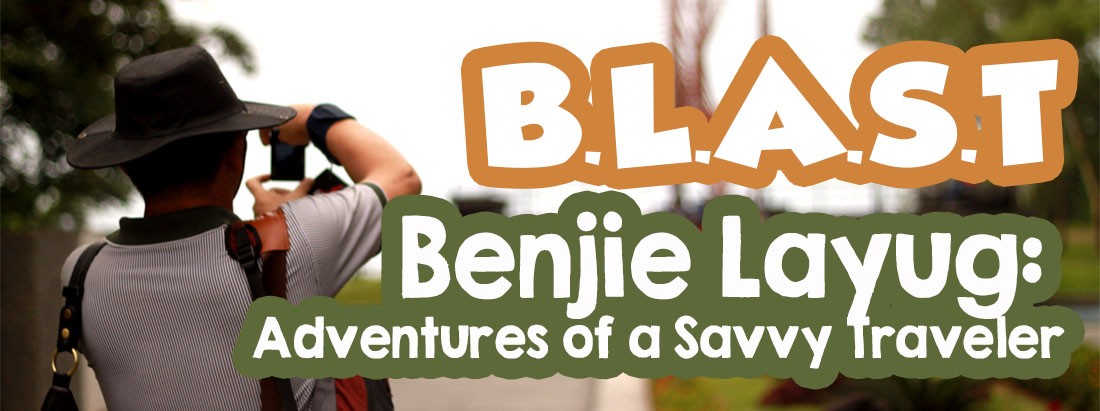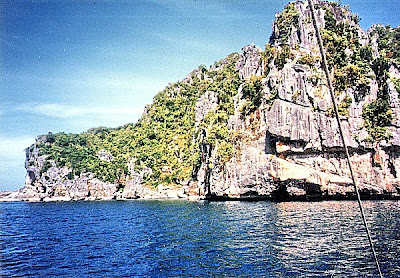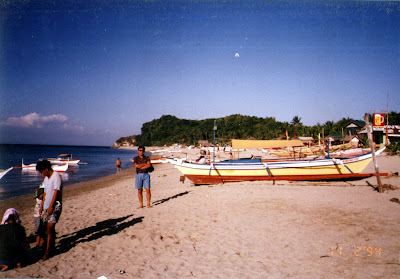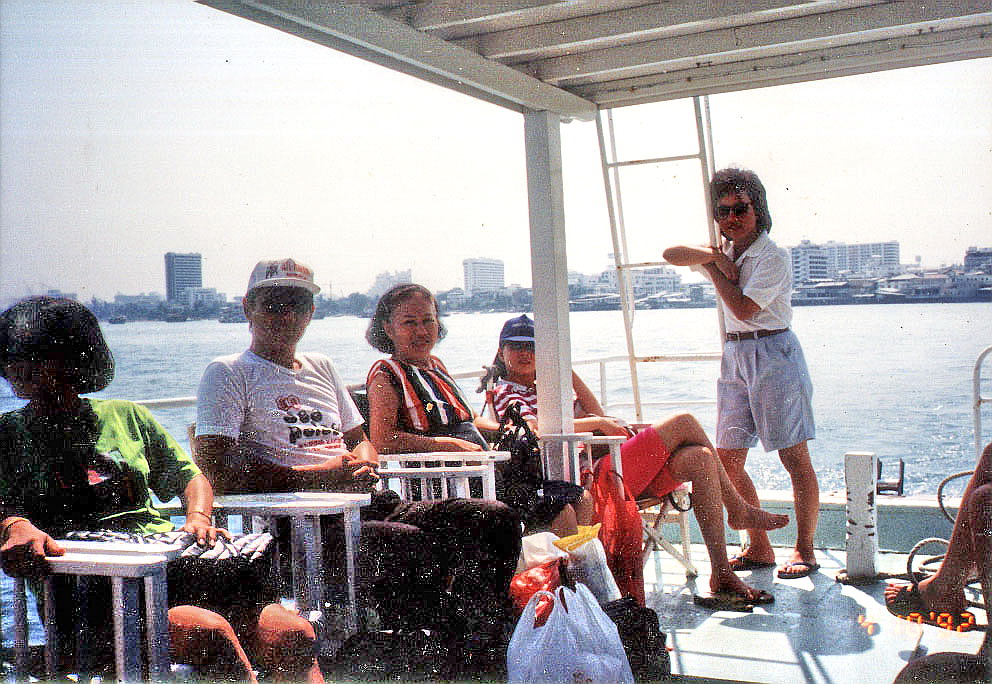 |
| The resort’s beach and catamaran |
On April 20, Holy Thursday, I decided to visit to Marabut Marine Park and Beach Resort in Marabut with my brother-in-law Manny and my son Jandy. Marabut is the last town before the border with Eastern Samar, off the southern coast of Samar. However, Manny’s car was trapped in the garage due street diggings along the street. Mr. Victor Macasera, my Astra medical representative guide to Sohoton Caves, came to our rescue by offering to bring us there. After our usual early morning breakfast and loaded with our usual picnic basket prepared by Paula, manny’s wife, we departed Tacloban City around 9 AM, crossed the San Juanico Bridge to Samar, turned right at the fork to Basey and proceeded, down a well-maintained road, to Marabut town.
 |
| Burial cave |
Soon, we espied the beautiful stack of small limestone islands of the marine park just off the horizon. Near the resort, we made a stopover at a small cave along the highway. Inside, we saw a cross, an image of the Blessed Virgin and a net-covered concrete vault containing the mixed up bones of victims killed by the Japanese during World War II. About a kilometer past the cave, we came upon the road sign and an 700-800 m. long access road leading to the resort. Past an old, wooden loggers’ lodge was the entrance to the resort. We parked our car and rented a picnic shed for our use.
 |
| The islands of the marine park |
This 1-hectare resort, opened in 1997, sits on a 90-hectare land planted with rice and coconut trees. It also has a reforestation area planted with mahogany and gmelina trees. The resort is owned by the Unimaster Conglomeration, Inc. of Mr. Wilson Chan, the same corporation that owns the Leyte Park Hotel in Tacloban City. It has 5 nipa, bamboo and wood duplex cottages with bath, an open-air restaurant and a bar. Being a holiday, the resort was full of Filipino-Chinese guests brought over from Leyte Park Hotel via a huge double-hulled catamaran moored along the beige sand beach. Beyond that were the 15 dramatic limestone islands that constitute the marine park, all leased from the local government for the exclusive use of the resort. Although filled with guests, the beach was surprisingly empty of swimmers.
 |
| All geared up and ready to go |
As we were going around the resort, we came across a group of tourists milling around a dazed man pockmarked with red sores from head to foot. He was just bitten by a jellyfish while swimming along the beach and was being administered with antibiotics. It was jellyfish season. No wonder the beach was empty. So much for the swimming. Still the limestone islands beckoned. As we were preparing the table and ourselves for lunch, I espied a number of brave sea kayakers heading towards the islands. I immediately made a reservation for a 2-pax, sit-on sea kayak. If I can’t swim along the beach, I could at least kayak. The resort has 8 plastic kayaks – 3 single and 5 double; plus one outboard motor boat. Kayak rental is PhP75 per hour, inclusive of life vests but with no helmets.
However, I was placed on a waiting list. There was nothing to do at the moment except eat, and eat we did. With food enough for double our party, we feasted on tipay (scallops baked in garlic), kilawin, pansit canton, grilled tilapia and steamed rice, all washed down with bottled water or canned soft drinks. We were too full to even touch the ripe mangoes for dessert. Pretty soon, the previous kayakers returned and as soon as the kayaks were parked, I immediately laid my claim to a kayak. Jandy and I quickly applied sun block lotion, packed our snorkels and camera in a dry plastic bag, donned our shades, rubber slippers and life jackets and were soon on our kayak.
Sea kayaking wasn’t a breeze as I first thought it would be. Jandy was seated up front and it took some time for us novices to coordinate our paddling and maneuvering efforts. For a time we seemed to be going nowhere, but soon we got the hang of our double oars and were soon on our way in a leisurely, exploratory pace. Still wary of going very far, I decided first to visit some of the mainland’s inaccessible and scenic hidden coves just around the beach. Going there only seemed to bring the islands closer to me and, with a little guts and a prayer, were soon paddling full speed ahead.
The nearest was a magnificent 3-peak island with a white sand beach tucked in between them. Shooting straight up from the sea like natural skyscrapers, the islands’ towering limestone cliffs’ base were heavily undercut by wave action and were topped by dense jungle. This scenery reminded me of similar islands (although more compact and much nearer) seen as I toured the equally beautiful Dimakya Island (Club Paradise, Coron in Palawan) and Gigantes Islands of Iloilo.
Pretty soon, after about 20 mins. of paddling, its white sand beach hove into view as the surrounding waters became clearer. We had to maneuver around to avoid some large rocks visible under the water and soon hit dry land. We were the only visitors there and we both felt like Robinson Crusoe (or is it Swiss Family Robinson?). We donned our snorkels and explored its clear waters and coral garden of staghorn and brain coral. No jellyfish in sight. Thank God. This condition was soon broken by the arrival of 3 other kayaks from the resort, all paddled by Filipino-Chinese guests of the resort. We gladly lent our snorkels (and rubber slippers) to the group.
I had my eye on visiting the next island’s white sand beach, and seeing a golden opportunity, suggested a joint kayaking safari with our new friends to the island. Our next destination was similar to the first except that its peaks were not as rounded. We reached it after 15 mins., but we were not the first arrivals as a large outrigger pumpboat loaded with tourists was already there even before we left the first island. Snorkeling here was quite a disappointment and the only floating creature I espied was a jellyfish! We quickly made a dash for the shore. Instead, I tried to go around the islands’ heavily undercut girt but soon gave it up upon reaching waist-deep water.
From the island we could espy the third island’s white sand beach (only 3 of the 15 islands have white sand beaches). In the distant horizon was the all too familiar Tooth Island, a bizarre, hourglass-shaped limestone outcrop (no beach) featured in a colored postcard. My spirit was willing but I was already tired. I decided to abandon the idea and instead started paddling, together with the others, back towards the mainland. Although tired, our strokes were more fluid, just like professional kayakers. After about 30 mins. we were back at the resort, having been gone for 2 hrs., dead tired and with aching muscles.
Jandy and I turned over our kayaks and life vests to Manny and Victor and they were soon kayaking to the nearest island. While they were away, I decided to interview Mr. Angel Quiminales, the resort manager. Angel gave me an overview of the resort’s beginnings, facilities and future plans including a future saltwater swimming pool and additional cottages. My heart sank when Angel told me of a hidden lagoon located just 400 m. from, and to the right, of the mainland beach. It sank even deeper when he told me that the second island I visited had a beautiful cave with beautiful stalactites just around the beach. It was a frequent destination for foreigners. If only I knew. After this 45-min. interview, we decided to call it a day, thanked Angel and paid our bills (picnic shed and kayak use). We left Marabut by 4 PM and were back in Tacloban by 5 PM. The next day, being Good Friday, I decided to rest.






















































